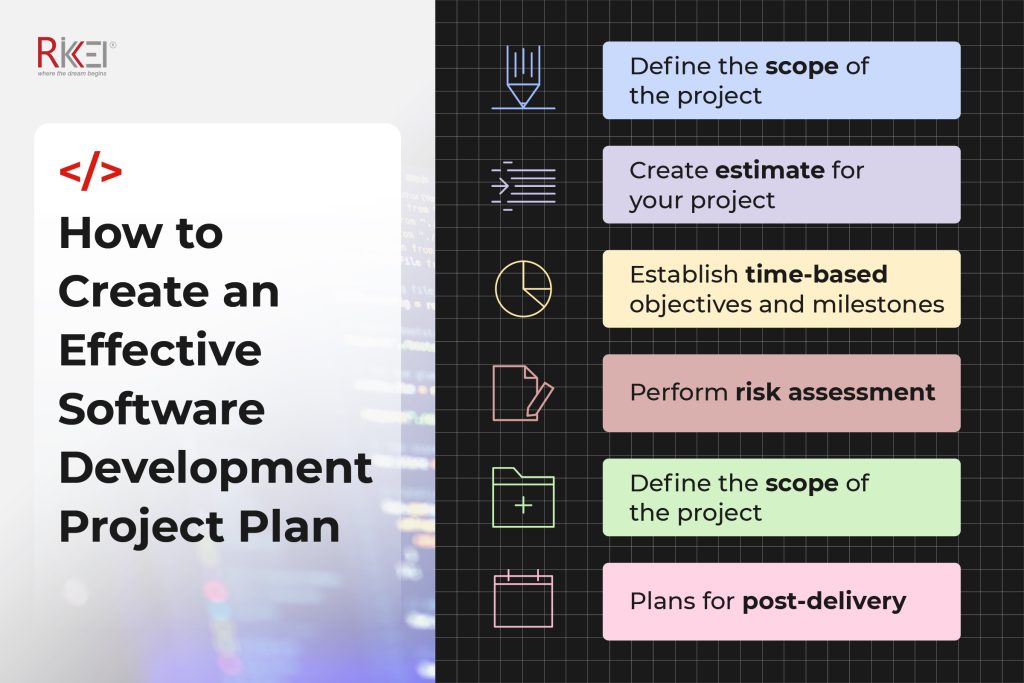The Complete Guide to Creating a Software Development Plan
Contents
It is important to have a plan when starting your software development project. Without a concrete plan as a guideline, your development team is susceptible to various pitfalls that can easily delay or derail your project entirely off-track. Therefore, you should know exactly what software development plans are, and how to create plans that cover as many aspects of the project as possible. Everything – and more – will be thoroughly discussed in this blog post.
What is A Software Development Project Plan?
A software development plan is what it claims to be: an overview of your development project. To be more specific, it would contain documents outlining the tasks and timeline of the project, as well as the following information:
- Team members
- Start and End dates
- Requirements
- Technologies
- Working procedures
- Training standards

Although it should be treated as a hard guideline for the project, your plan can (and should) be following a flexible progression. With flexibility in the software development plan, managers can adjust on the fly to meet goals while developers are able to easily go back and forth between different stages of the project to continuously fix and reiterate versions of the software. A big part of software development is troubleshooting and making sure everything is free of bugs, so having the ability to redo parts of the software as needed without impacting the overall progress is valuable.
Additionally, software development project plans should include a detailed assessment of threats and risks the project is facing, alongside any backup plans should things go awry during development.
What Are The Goals of Planning Software Development Projects?
In software development projects, planning should aim to achieve some or all of these goals:
- Specifying roles and responsibilities
Roles and responsibilities are the backbone of planning. Assign parts of the software development project to qualified members (for that part), then have the assignments documented. This saves you from a headache later on in the project and forces your team members to take responsibility and accountability for their part from the very start.
- Clarifying requirements
Creating a plan before going into development helps define what your client wants exactly. During planning, it is recommended that you stay in contact with the client and work alongside their feedback to make sure that their needs are met in the software.
- Keeping up with deadlines
With a plan, you can effortlessly create timeframes for the completion of each part of the project. These timeframes serve both as a visualization of project milestones, and a way to keep your team motivated throughout the project as progress is observed through the tangible dimension of time.
- Adhering to the budget
Your plan, ideally, should cover the budget minutely, including accounting for sudden changes. Having the budget well-documented is a constant reminder for your team to stay within the monetary boundaries of your project. Additionally, the manager can keep an eye on parts that could break the budget and resolve the issue accordingly.
- Ensure functionality
In the end, what matters the most is the quality of your software product. A plan with quality assurance embedded into stages of the development process allows for more vigorous testing and bug-catching before delivery to your client.
Why Do You Need A Software Development Plan?
Now you know what you should aim for when creating a software development plan, but do you really need it? It seems so redundant and pointless; one can even call it a waste of time and money when all that can go into development itself!
It is true that development can start without a concrete plan in place. Solo developers can build a simple project in less than a day, and they are most likely not going into it with a hyper-detailed plan listing everything that they wanted to cover. However, that way of thinking does not scale well at all.
When your project involves hundreds of people and even much more in monetary terms, running it blindly without a plan can only result in losses for you, your development team, and your client. Things that could happen here include:
- Unrealistic expectations of cost, time, or manpower
- Delayed product delivery
- Overbudgeting
- Development crunches
It is common for big enterprises to fall into these traps and have their software development project drawn out more than needed, however, this need not be the case. You can outsource your software development to a tech company with more experience than you in the software development field, like Rikkeisoft.
With more than 10 years of experience in outsourced software development, Rikkeisoft’s teams of senior developers are ready to assist you in creating the best software for your needs.
If you are still set on developing your own project from scratch with your in-house team, continue on to find out how you can create an effective software development plan to avoid common pitfalls.
How to Create an Effective Software Development Project Plan?
Here is the software development tasks list:

1. Define the scope of the project
The scope of your project is the target you would want your project to hit, and it will be the central pillar that everything else has to be built around. Therefore, the premier imperative for planning software development projects must be clearly defining the scope.
To start defining your scope, work with your client (or development team, if you are the project manager) closely at the beginning of the development cycle. The major aspects of the project, such as budget, outcome, expected time frames, tasks, and final delivered products, are to be discussed in depth to figure out the final scope of the project. This scope will then become the staple of your entire development project.
If the development cycle is expected to take a longer period of time (6 months or longer is the norm), it is advised to plan for the first 6 months only. At that point in time, you ought to hold another meeting to reset your plan. Assess your old goals and adjust them to align with the new direction, should they have to be changed. This way, your development team is kept up to date with the newest changes and you are not in the dark regarding their current progress.
2. Divide the project and outputs
No one can tackle the gargantuan task of building a software development project all at once. Split it into smaller tasks!
Small tasks help you manage the project better – after splitting, you can decide how to allocate your budget according to the tasks themselves, and it is easier for you to have members of your team manage their own part of the development process rather than you having to do all the work.
After the split, clarify what you would want each team of developers to do and what the expected outcome for them is. This is another step that would benefit greatly from a meeting between the client and the team since a successful result can only be defined by the client themselves. Having a clear image of what needed to be done helps the development team avoid major redesigns and change requests later down the line.
Keep a note of every task you assigned as well as the output each task wanted. Failure to do so would render the whole splitting stage of software development planning moot. Plus, concise documentation gives you a better overview of the entire development process. You can easily see where your project would bottleneck and set out to resolve it even before development.
3. Create estimates for your project
It is important for a project manager to know what their team members can realistically do, from the members themselves. Create a meeting where every member can voice out their opinions regarding their own abilities and the time and/or budget it would take them to do their task realistically.
Make sure that everyone has a chance to participate and not have one dominant personality rule over the process. You should also be as unbiased as possible going into estimation, and resist giving your team suggestions on the matter – you are looking for their thoughts, not yours.
Estimations are not fail-proof however, and you will need to ask your team questions about their assumptions. Use open-ended questions like “How will this be achieved?” or “Why did you make that suggestion?” to help your team dig deeper into their thought process and reflect on new information achieved by answering the question.
By creating estimates and then reevaluating them through questions, the final results will now be much closer to reality. Even then, it is better to have a backup plan built upon the estimates – 15-20% should be adequate – to cover any error that might happen during development. The bigger your project is, the more contingency there needs to be for development.
Estimates can also be grounded by gathering and analyzing project data. The data provides you with a realistic overview of how the project is going, and whether your time and budget estimates are correct. Have your data collected at set intervals of time and adjust your plans accordingly.
4. Establish time-based objectives and milestones
Now that you know when your team can finish their work through estimates, you can create milestones for your software development project plan. Milestones are a great way to keep track of the development progress and help both the client and the development team tremendously.
For the client, having milestones assists them in regularly tracking the development project. Instead of having to ask developers for their current progress, the client can now easily look at milestones and have their own answers quickly. This saves the client time and effort of having to figure out everything on their own.
For the development team, having milestones means they can focus on doing one thing for a period of time before moving on to the next milestone in the schedule. Not having to waste time doing something that is not related to the current task also saves your development team a lot of time. The time can then be allocated to different, more useful tasks during development.
With milestones set, you can easily create schedules for your development teams. These schedules should have milestones as their starting point and be adjusted for each individual team’s needs. Having a schedule as a point of reference makes managing each part of the development process much simpler.
5. Perform risk assessment
With proper risk assessment, project managers can identify potential issues in a software development project early to prevent them from spreading and affecting other processes, hampering the project altogether. After identification, plans are made to ensure that the aforementioned issues would be resolved long before they happen in real life.
Inevitable delays due to external reasons should also be covered during risk assessment, though one might argue they are potential issues. As thorough as you can be in listing out potential obstacles, ultimately you are not omniscient and cannot predict the future. As such, planning for delays is still recommended for anyone planning a software development project.
Lastly, your risks and issues should be maintained as a list, with their solutions attached to the same document. Log any new problem that arises as well, to make managing your project easier.
6. Plans for post-delivery
Your team’s support for the software project should not end at delivery. Make plans for the entire delivery process, including the transition of your software to the team that would perform maintenance. Be ready to also provide post-release support to strengthen the relationship between your development team and the client.
Since development teams are often created and disbanded on a project-to-project basis, planning for a post-project review before the actual project itself helps inform people in your team about the stage and lets you allocate resources, however scarce they are at this point, to it. Ignoring a post-project review in software development costs you time and efficiency in future projects, having to retread your steps over and over again.
In a post-project review, again, ask your team open-ended questions for better reflection between members and themselves. Some of the questions can be:
- What did we learn from the project?
- What went well, and how can we apply that to other projects?
- What went off-track? How can it be fixed and/or avoided?
- Were goals for the project achieved?
Tips for Effective Software Development Plans
Create accessible guide documents
The software development plan’s documents must be easily accessed by your team members. This means anyone can quickly find them, open them on their own devices, and then read them through.
The documents should also be well-organized and easy to read. Look for ways to improve readability (through language, formatting, and wording) for your software development plan documents before sending them out to members of the team. Be sure to ask for feedback from members on your plans as well – you do not want anyone to be out of the loop and hinder the progress of your project, just because of a technical problem with their version of the plan.
Use software tools
To simplify your management process, use external software to create a project development plan. These tools offer the ability to easily create, edit and share information-laden plans with team members, saving you time and energy for other tasks that require more attention.
Frequently Asked Questions in A Software Project Plan
During your software project planning, it is vital to have clear answers to these questions:
- Who will be involved in the project?
- Why is the project worked on?
- What are the goals of the software?
- When is the expected delivery date?
- How will the project be delivered?
- How much can the project cost?
Your development team should have these answers ready for them so that no time or manpower is wasted on unneeded tasks. In order to do so, in the first meeting held between the development team and their clients, the clients should specify their needs and requirements as clearly as possible and answer all six questions in the process. Clients should also be timely informed of the development progress to prevent the project from straying away from their vision.
Closing Thoughts
There are a lot of factors and issues that can arise during software development projects, further complicating what is already a complex problem to solve. Thankfully, you can prepare by planning ahead of the development cycle and avoid headaches later on. Alternatively, outsource your software development project to someone with experience in the field like Rikkeisoft, and be certain that your project is well-planned and organized by the outsourced software developers.
More From Blog

October 28, 2025
Australia’s Fintech Revolution: Trends Shaping the Future of Digital Finance
Australia has emerged as one of the most dynamic fintech hubs in the Asia-Pacific region, driven by strong consumer demand for digital financial services, supportive government regulations, and the widespread adoption of innovative technologies. As the industry matures, the imperative for digital transformation has become unmistakable: fintechs and financial institutions alike are under pressure to […]

August 12, 2025
AI and Big Data in Building Smart Insurance Platforms
The insurance industry is now standing at a pivotal moment in its digital evolution. Traditional insurance models built on historical data analysis and reactive risk assessment are rapidly giving way to intelligent, predictive platforms powered by artificial intelligence and big data analytics. This transformation represents more than technological modernization; it’s a fundamental reimagining of how […]

July 23, 2025
Insurtech’s Game-Changing Trends: How AI and Digital Transformation Are Reshaping Insurance
The financial technology sector is experiencing unprecedented change, making it essential for business leaders and technology professionals to stay ahead of emerging innovations. Throughout 2025, insurance technology (insurtech) has emerged as a powerful catalyst for change, fundamentally altering how insurance providers conduct business, engage with clients, and assess risks. This technological evolution represents more than […]

April 4, 2024
Big Data Performance: Maximize Your Business Value
In today’s data-driven world, organizations are constantly generating and collecting immense amounts of data to understand their customers more deeply. This data, often referred to as “big data,” holds immense potential for organizations to seek opportunities and overcome challenges. But accessing and analyzing big data isn’t enough to have proper strategies; organizations must pay attention to […]

April 4, 2024
How Real-Time Data Analysis Empowers Your Business
In today’s fast-paced business landscape, the ability to quickly make data-driven decisions has become a key differentiator for success. Real-time data analysis, the process of analyzing data as soon as it’s generated, has emerged as a powerful tool to empower business across industries. By leveraging real-time data analysis, organizations can gain timely and actionable insights, […]

April 4, 2024
Differences Between Data Science and Computer Science
Data Science and Computer Science are distinct fields overlapping in certain areas but have different focuses and objectives. The article below will help you clearly understand the differences and the close connection between the two fields. What is Data Science? Data Science is an interdisciplinary field that combines scientific methods, processes, algorithms, and systems to […]

